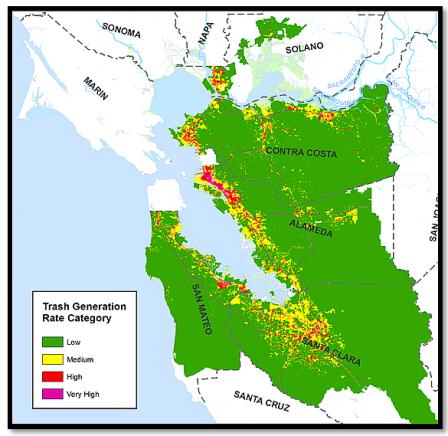The Clean Water Act and Trash-Free Waters
While preventing trash at the source is the preferred method to achieve trash-free waters, what can we do about trash that has already made it to the streets and our waterways?
The Clean Water Act provides regulatory tools for states and communities to address aquatic trash. These tools inclde trash TMDLs and stormwater permits as well as trash capture technologies that physically trap aquatic trash in stormwater systems, rivers, lakes, estuaries and coastal areas across the country.
- Clean Water Act Tools for Trash
- Existing Trash TMDLs and Stormwater Permits
- Trash Capture and Removal Technologies
Clean Water Act Tools for Trash
The Clean Water Act tools for preventing and treating trash in waters include:
- 303 (d) listings for trash impairment,
- Total Maximum Daily Load (TMDL) for trash, and
- National Pollution Discharge Elimination System (NPDES) stormwater and combined sewer permits.
The Clean Water Act requires all states to submit a Section 303(d) list to EPA every two years to identify all waters where required pollution controls are insufficient to attain water quality standards. The 303(d) list identifies the impaired and threatened waters and the pollutant or pollutants of concern for that water body.
Over 200 individual water body reaches in 7 states including Alaska, California, Connecticut, District of Columbia, Hawaii, Maryland, and New York have been listed for trash, debris or floatables since 1996.
The 303 (d) list helps establish priorities for development of TMDLs or other measures to clean up waterways. A TMDL may not be required in all cases. In a TMDL, the sources of the pollutant are identified, and each source is assigned a maximum daily amount it is allowed to release. TMDLs can assign portions of the pollutant load to point sources and non-point sources.
When point sources, such as stormwater collection systems, are identified as a pollutant source in a TMDL, then NPDES discharge permits must include provisions to achieve targeted reductions for that pollutant as specified in the TMDL. EPA policy allows states to remove water bodies from the 303 (d) list after they have developed a TMDL or after other measures have been taken to meet water quality standards.
Trash is a pollutant. Trash in waters can prevent beneficial uses, degrade habitats and harm wildlife, and may endanger people's health. Although many jurisdictions may not have recognized trash as a traditional pollutant like mercury or sediment, water bodies around the U.S. have been listed as being impaired for trash and/or floatables and debris. Listings can be a crucial first step in identifying and prioritizing waters polluted with trash. The next section explores specific examples of TMDLs and NPDES stormwater discharge permits that set limits for trash.
Trash TMDLs and Stormwater Permits
Stormwater is water collected from runoff, typically from streets and parking lots, which often carries trash and other pollutants. Combined sewer and stormwater systems carry sewage and stormwater to treatment plants before being discharged into water bodies. In contrast, stormwater systems that are separate from sewers, known as Municipal Separate Stormwater Systems (MS4), collect runoff and discharge it to waterbodies without going through a treatment plant. However, combined sewer and stormwater systems may also release untreated water containing trash when overflowing during heavy rain events.
Studies show that most trash is generated on land and then transported to a receiving water body. The main transport pathway of trash(1 pp, 1.8MB, About PDF) Exit to receiving waters is through stormwater, a point source. However, non-point source pathways, such as direct dumping of trash in a water body or wind blown transport, may also be locally significant sources of trash in water bodies.
Some jurisdictions have pursued trash TMDLs, which can take years to establish and may have significant costs. Other jurisdictions have written provisions into stormwater permits to require measurable reductions in trash discharge. Using NPDES permits to address point sources of trash significantly reduce the amount of trash reaching lakes, rivers, estuaries and oceans.
Below are a few examples of jurisdictions addressing trash through TMDLs and stormwater permits.
- Los Angeles River Trash TMDL
California
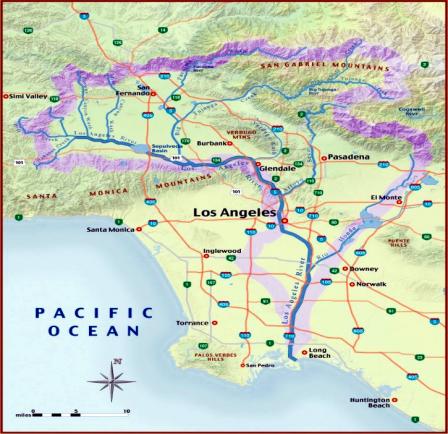 LA River BasinGoal: 0% trash by 2016
LA River BasinGoal: 0% trash by 2016Area: 834 Square Miles
Population: 5 million people
Baseline trash load: 5 million pounds per year
Links: LA River TMDL (PDF) | Los Angeles County MS4 Permit (PDF) ExitThe Los Angeles region has been a pioneer in using Clean Water Act tools to address trash. It began with adding water bodies to the 303 (d) list for trash impairments in 1996. Today, there are more than 10 trash TMDLs in the region. The Los Angeles River had one of the nation's first trash TMDLs when it was established in 2001. This TMDL affects the largest area in the LA region (see map outlining the LA River Watershed). Storm drains were identified as the major source of trash in the river, and specific baseline loads were assigned to each of 42 municipalities and the transportation department. Non-point sources were not included, but a list of specific parks and public areas were directed to establish a minimum frequency of litter cleanups and an assessment program to eliminate trash washing off their sites.
For stormwater permittees to reach the targeted 100% trash load reduction by September 2016, permitees can use full trash capture devices or partial capture devices and institutional controls such as street sweeping, litter law enforcement, etc. Partial capture devices and institutional controls require monitoring to measure effectiveness. Many jurisdictions have used full trash capture devices because it's the most straightforward approach.
For example, the City of Los Angeles, responsible for about 2.5 million of the annual 5.4 million-pound baseline load, reached compliance almost exclusively using trash capture devices, spending $75 million to retrofit over 38,000 catch basins and about 15 large in-line devices. Read more about these devices under Trash Capture and Removal Technologies [NEEDS LINK].
- New York City Stormwater Permit
New York
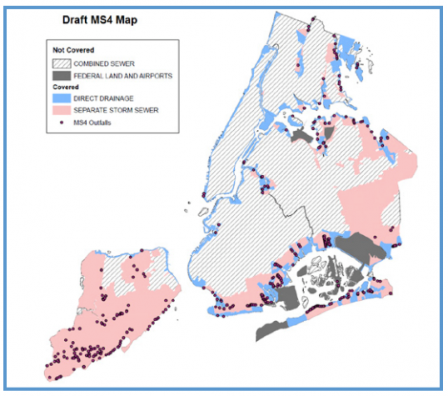 Goal: Establish the loading rate of trash, debris, floatables and settleables in the receiving waters.
Goal: Establish the loading rate of trash, debris, floatables and settleables in the receiving waters.Area: 304.6 Square Miles
Population: 8.4 million people
Baseline trash load: TBD 2020
Links: State Pollution Discharge Permit (PDF) ExitUnder New York City's 2015 MS4 permit, the city is developing a floatable and settleable trash and debris management program as part of its Stormwater Management Program Plan. The goal is to develop a methodology to determine the loading rate of floatable and settleable trash and debris, including land-based sources, from the MS4 to water bodies listed as impaired, conduct a loading rate study, and adopt strategies to reduce floatable and settleable trash and debris. Additionally, NYC will implement an interim floatable and settleable trash and debris education media campaign to further educate the public on trash and debris control issues.
- San Francisco Bay Stormwater Permit
California
Goal: 0% trash by 2022
Area: 2,576 Square Miles
Population: 7 million people
Baseline trash load: ~1.3 - 2.5 million pounds per year
Links: 2009 Municipal Regional Permit (PDF) | 2015 Municipal Regional Permit ExitIn the San Francisco Bay Area, portions of the Bay and most of its tributaries had been 303(d) listed for trash. Rather than establishing individual TMDLs, in 2009 trash provisions were included in the Phase 1 Municipal Regional Stormwater Permit, which covers 76 MS4 permitees. Using land use data, areas were categorized into 'Low' 'Medium', 'High' and 'Very High' trash generating areas on the basis of gallons of trash produced (for example, Medium Trash Generation areas produce 5-10 gallons/acre/year). Permitees are required to implement trash controls in all areas, except 'Low' trash generating areas, using a combination of trash capture devices and institutional controls.
The permit requires at least 5,700 acres to be treated by full capture devices. By 2015, over 25,000 acres were covered by these systems, demonstrating that trash capture can be an effective solution. A unique feature of this permit is a 'hotspots' requirement that applies to creek or shoreline areas with the most trash. Each permittee must identify one 'hotspot' for every 30,000 residents, and do at least one cleanup of each hotspot every year. Hotspot cleanups are particularly effective in removing trash from non-point sources such as illegal dumping. In addition, permittees may claim percentage reductions for reducing the sources of trash through measures like street-sweeping.
- California Statewide Trash Policy
California
 Goal: 0 % trash by 2030
Goal: 0 % trash by 2030Area: 164,000 square miles
Population: 39 million people
Baseline trash load: Unknown
Links: Policy Document | Video ExitStatewide, 73 water bodies are listed for trash or debris impairments. Based on lessons learned in Los Angeles and the San Francisco Bay Area, California adopted a statewide policy to address trash uniformly in areas without trash TMDLs and/ or permits. The policy establishes a narrative water quality standard for trash that applies to all state waters and requires all stormwater permits to be modified or reissued to include trash provisions. Stormwater permitees, like cities and counties, will create a trash implementation plan to reach zero trash within 10 years of the newly adopted permits, but no later than 2030.
Each plan must address high trash-generating areas such as 1) high-density residential areas (10+ dwelling/acre), 2) industrial and commercially-zoned land, 3) mixed urban, 4) public transit corridors, 5) on- and off- ramps in high trash areas, and 6) rest areas and park-and-rides. The policy will apply to approximately 17,000 permittees and will require treatment and control of trash for more than 600 square miles. Compliance may be demonstrated through either 1) use of trash capture devices on an entire stormwater system, or 2) some combination of trash capture devices and institutional controls like street sweeping, sufficient to reach reductions equivalent to full capture. The policy also allows local regulators the option to require trash controls for non-point sources of trash, such as heavily used campgrounds, picnic areas, beaches and marinas. This approach is more efficient since it doesn't require a TMDL for each water body, which can be time consuming and expensive. It does require immediate action for controlling stormwater sources of trash, which are the main transport pathway.
- City and County of Honolulu Stormwater Permit
Hawaii
 Goal: 0 % trash by 2034
Goal: 0 % trash by 2034Area: 2,128 square miles
Population: 1 million people
Baseline trash load: TBD 2017
Links: MS4 Permit (PDF) Exit
In 2012, trash provisions were added to the stormwater permit for the City and County of Honolulu (CCH). The 2012 permit directed CCH to create baseline estimates, a long term and short term reduction plan, and target dates to reach 50% and 100% reduction. The short term and long term plans, which included proposed methods for baseline calculations, were submitted in 2014. The baseline calculations are scheduled to be completed in 2017. The goals are to reach and 50% reduction by 2023 and 100% reduction by 2034.
Trash Capture Technologies
Many types of trash capture technologies are available. They have been rapidly evolving across the world in recent years to solve unique trash problems in waterways. Aside from the upfront capital costs of trash capture technologies, systems may also require ongoing maintenance to routinely remove accumulated trash and debris. Particularly in areas with heavy trash loads in urban runoff, trash capture devices can be an effective and efficient trash management practice.
The use of different trash capture technologies is heavily dependent on municipal budget and capacity for operation and maintenance, local hydrology, and many other site-specific considerations. Examples shown below include some that are generic and non-proprietary, while others are custom-designed for a specific location. They do not reflect any preference or endorsement by U.S. EPA.
Trash Capture Technologies can be deployed at different locations, including:
- Stormdrain inlets, the entry points to the stormwater system,
- In-line, within the pipes or at the outlet of the stormwater systems,
- Open-water, such as a floating boom in the receiving water body.
Storm Drain Inlet Trash Capture Technologies
- Curb Inlet Covers
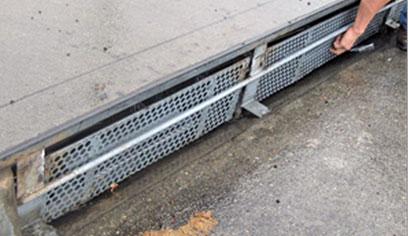 Trash screens are designed to keep trash on the street and stop trash from entering the stormdrain system. This way trash is kept on the street, so it can be swept up by street sweepers before it reaches the catch basin. The styles and sizes of openings differ, so these devices differ in their effectiveness.
Trash screens are designed to keep trash on the street and stop trash from entering the stormdrain system. This way trash is kept on the street, so it can be swept up by street sweepers before it reaches the catch basin. The styles and sizes of openings differ, so these devices differ in their effectiveness.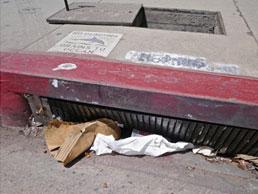 Automatic retractable screens, as shown in the top photo, open up once a certain force or pressure is created. This prevents flooding in case the screen gets clogged with trash.
Automatic retractable screens, as shown in the top photo, open up once a certain force or pressure is created. This prevents flooding in case the screen gets clogged with trash. - Catch Basin Outlet Screens
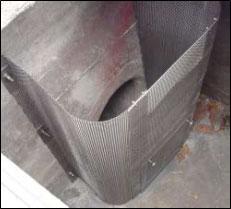 Catch basin outlet screens are installed inside stormdrains. These are screens or filters that block trash from entering stormwater intake pipes. Those with mesh size >5mm can be certified as 'full capture devices' in California. Often screen systems will release trash if overflows occur.
Catch basin outlet screens are installed inside stormdrains. These are screens or filters that block trash from entering stormwater intake pipes. Those with mesh size >5mm can be certified as 'full capture devices' in California. Often screen systems will release trash if overflows occur.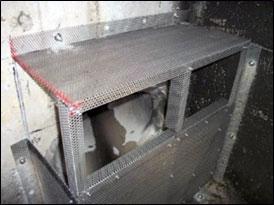 Reinforced models such as the one on the bottom right, have evolved through experience with local hydraulics in the Los Angeles County MS4 system.
Reinforced models such as the one on the bottom right, have evolved through experience with local hydraulics in the Los Angeles County MS4 system.Curb inlet covers may be used in combination with catch basin inlet devices in areas with very high trash to act as a first line of defense and to prevent the need for more frequent clean-outs of internal catch basin devices.
- Catch Basin Hoods
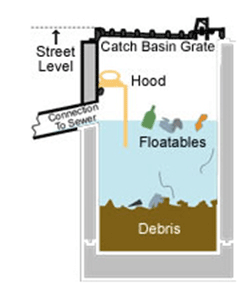 Catch basin hoods are installed within a catch basin in front of the outlet pipe, with the hood bolted to the manhole. Hoods form a baffle against floatable litter, preventing large floatables like aluminum cans and bottles from getting into the sewers or stormwater pipes. Hoods are not full-capture devises, and therefore, must be used in-series with other trash capture methods to ensure full capture. Catch basin hoods should be equipped with anti-siphon devices, and coupled with deep-sump catch basins, in order to maximize the capture of both floatable and settleable trash.
Catch basin hoods are installed within a catch basin in front of the outlet pipe, with the hood bolted to the manhole. Hoods form a baffle against floatable litter, preventing large floatables like aluminum cans and bottles from getting into the sewers or stormwater pipes. Hoods are not full-capture devises, and therefore, must be used in-series with other trash capture methods to ensure full capture. Catch basin hoods should be equipped with anti-siphon devices, and coupled with deep-sump catch basins, in order to maximize the capture of both floatable and settleable trash. - Catch Basin Fabric Inserts
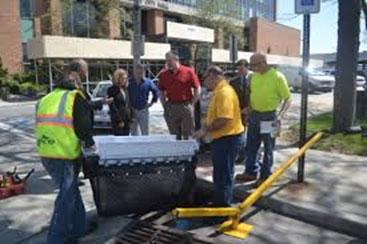 Catch basin inserts are widely used as stormwater best management practices for trash capture. They are a relatively easy and inexpensive retrofit, particularly for older, existing drainage systems where end-of-pipe treatment technologies may be impractical or prohibitively expensive. Permanent inserts usually require steel frames, high-flow bypass, and durable fabric filter material that can hold up to storms, debris loading, and cleanings. These drop-in inserts can allow inspection and cleaning without catch basin grate removal, and may achieve full capture.
Catch basin inserts are widely used as stormwater best management practices for trash capture. They are a relatively easy and inexpensive retrofit, particularly for older, existing drainage systems where end-of-pipe treatment technologies may be impractical or prohibitively expensive. Permanent inserts usually require steel frames, high-flow bypass, and durable fabric filter material that can hold up to storms, debris loading, and cleanings. These drop-in inserts can allow inspection and cleaning without catch basin grate removal, and may achieve full capture.
In-Line and End of Pipe Trash Capture Technologies
- Linear Radial Devices
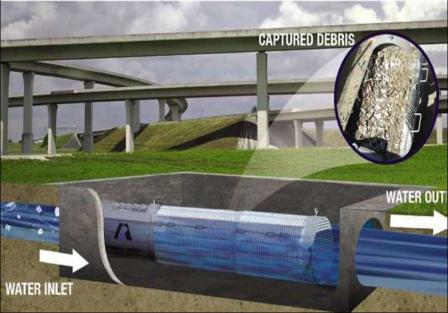 A Linear Radial Device is a rigid louvered linear screen cage constructed in a cement vault. Stormwater and trash enter the cage and the water flows through the cement box while trash is retained within the screen cage. Vacuum trucks and other trash removal equipment are required to clean the units. Installations require adequate space for maintenance. Installations can be shallow, open to the air and screen openings can be custom sized.
A Linear Radial Device is a rigid louvered linear screen cage constructed in a cement vault. Stormwater and trash enter the cage and the water flows through the cement box while trash is retained within the screen cage. Vacuum trucks and other trash removal equipment are required to clean the units. Installations require adequate space for maintenance. Installations can be shallow, open to the air and screen openings can be custom sized.Linear radial devices require low hydraulic pressure to operate. They can be used at any collection point and can treat large areas. They are well suited for narrow and flat rights-of-way with limited space, and are often used in linear systems such transportation corridors.
- Hydrodynamic Separators
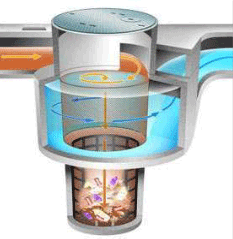 Hydrodynamic separators are widely used in stormwater treatment. They are flow-through structures with a settling or separation unit to remove sediments, floatables, and other pollutants.
Hydrodynamic separators are widely used in stormwater treatment. They are flow-through structures with a settling or separation unit to remove sediments, floatables, and other pollutants.Hydrodynamic separators come in a wide size range and some are small enough to fit in conventional manholes. Depending on the type of unit, this separation may be by means of swirl action or indirect filtration.
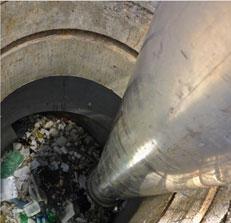 These inline systems are cleaned using vacuum trucks to pump out trash, sediment, and water that has collected at the bottom. These are generally high flow capacity devices, and can be from 10 to 30 feet deep.
These inline systems are cleaned using vacuum trucks to pump out trash, sediment, and water that has collected at the bottom. These are generally high flow capacity devices, and can be from 10 to 30 feet deep.Engineering and installation costs can be quite high, but the devices are long lasting and can capture trash from a considerable area. They can be installed as inline/online or offline units; and can be pre-cast or cast-in-place. The cast-in-place models are meant to handle greater flows. This also means that construction costs will rise, since these are deep installations and require consideration of other nearby infrastructure.
- Netting Systems
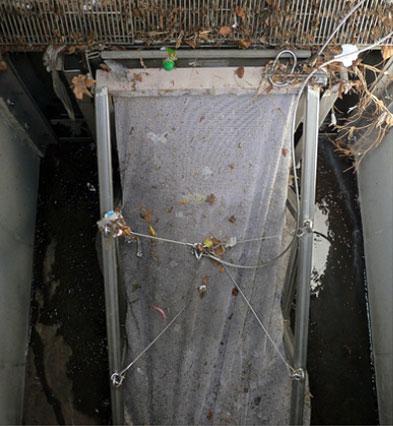 Netting systems may be designed with different size netting for various uses and may be in-line or end-of-pipe systems. In-line netting (upper photo) is installed underground in concrete vaults and functions similarly to the linear removal devices. Netting systems have one or more mesh bags and a metal frame guide system to support the nets. When full, nets are removed and replaced with new nets.
Netting systems may be designed with different size netting for various uses and may be in-line or end-of-pipe systems. In-line netting (upper photo) is installed underground in concrete vaults and functions similarly to the linear removal devices. Netting systems have one or more mesh bags and a metal frame guide system to support the nets. When full, nets are removed and replaced with new nets.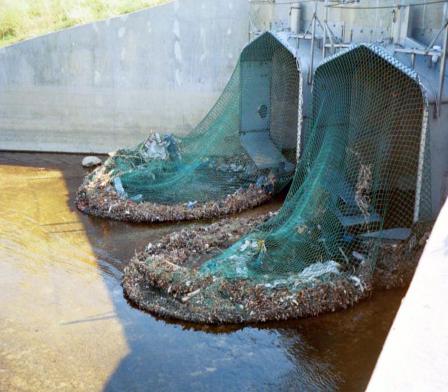 End-of-pipe systems may be at an actual discharge point to a receiving water, or just a collection point such as this flood channel. Because end-of pipe nets are above ground, they must be inspected at regular intervals to find and repair any damage from vandalism or other factors.
End-of-pipe systems may be at an actual discharge point to a receiving water, or just a collection point such as this flood channel. Because end-of pipe nets are above ground, they must be inspected at regular intervals to find and repair any damage from vandalism or other factors.
Open Water Trash Capture Technologies
- Litter Booms
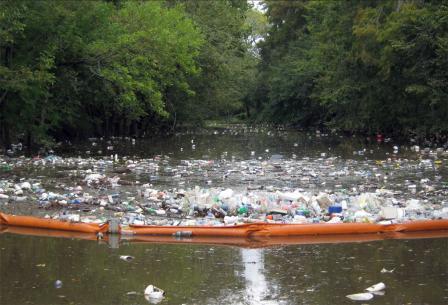 Booms have been widely used to capture floatable trash in waterways. Booms use floatation structures with suspended curtains designed to capture buoyant materials and can also be designed to absorb oils and grease. They are typically anchored to a shoreline and the bottom downstream of one or more outfalls.
Booms have been widely used to capture floatable trash in waterways. Booms use floatation structures with suspended curtains designed to capture buoyant materials and can also be designed to absorb oils and grease. They are typically anchored to a shoreline and the bottom downstream of one or more outfalls.Booms are custom-sized based upon the expected volume of floatables that can be released during a storm event. After a storm, material captured in the boom can be removed manually, with an excavator, a by a skimmer vessel.
- Trash Skimmer Vessels
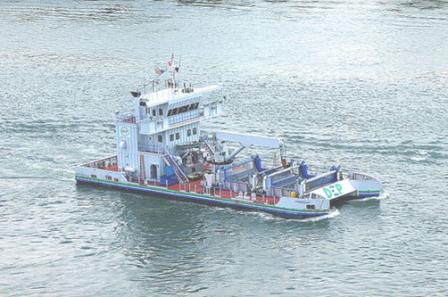 Skimmer vessels are specially-designed boats used to collect floating debris. They almost always require companion equipment, including a shore conveyor for offloading, a truck for disposal, and a trailer for land transport.
Skimmer vessels are specially-designed boats used to collect floating debris. They almost always require companion equipment, including a shore conveyor for offloading, a truck for disposal, and a trailer for land transport.Floatables are brought on board the vessel with moving screens on a conveyor belt system, or by lowering large nets into the water. Skimmers are used primarily in lakes, harbors, and bays and are usually custom made to meet site-specific challenges. Skimmers are used around the nation. The New York City Department of Environmental Protection's largest skimmer vessel, 'MV Cormorant,' is shown here.
- Bandalong Litter Trap
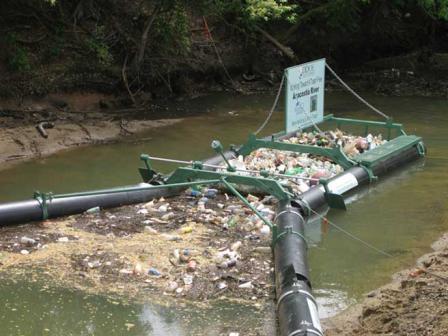 Boom and skimmer concepts have been combined in the Bandalong Litter Trap which is designed to float in waterways, capturing litter by using the current to guide debris into the trap. Bandalongs have been installed in a few locations, including along the Anacostia River in Washington, D.C., shown here after a rain event.
Boom and skimmer concepts have been combined in the Bandalong Litter Trap which is designed to float in waterways, capturing litter by using the current to guide debris into the trap. Bandalongs have been installed in a few locations, including along the Anacostia River in Washington, D.C., shown here after a rain event. - Baltimore Harbor Trash Wheel
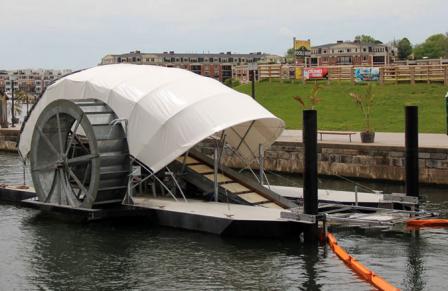 Here, the boom concept has been ingeniously adapted into the Baltimore Trash Wheel Exit. The solar-powered wheel is equipped with a conveyer belt. As the wheel turns, garbage and other debris travel up the belt and are deposited into a dumpster for disposal on land.
Here, the boom concept has been ingeniously adapted into the Baltimore Trash Wheel Exit. The solar-powered wheel is equipped with a conveyer belt. As the wheel turns, garbage and other debris travel up the belt and are deposited into a dumpster for disposal on land. - Trash Trap
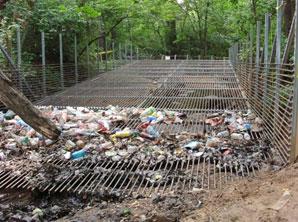 The Nash Run Trash Trap Exit shown here was custom designed and constructed for the Nash Run tributary of Washington, D.C.'s Anacostia River. It was designed to mimic Japanese fishing traps and was built with metal rods and posts. This inexpensive trap is designed to capture trash throughout the water column. The stream flow pushes trash, leaves, and branches along the screen, keeping the screen free from clogging. Routine maintenance is needed to remove the accumulated trash.
The Nash Run Trash Trap Exit shown here was custom designed and constructed for the Nash Run tributary of Washington, D.C.'s Anacostia River. It was designed to mimic Japanese fishing traps and was built with metal rods and posts. This inexpensive trap is designed to capture trash throughout the water column. The stream flow pushes trash, leaves, and branches along the screen, keeping the screen free from clogging. Routine maintenance is needed to remove the accumulated trash.

